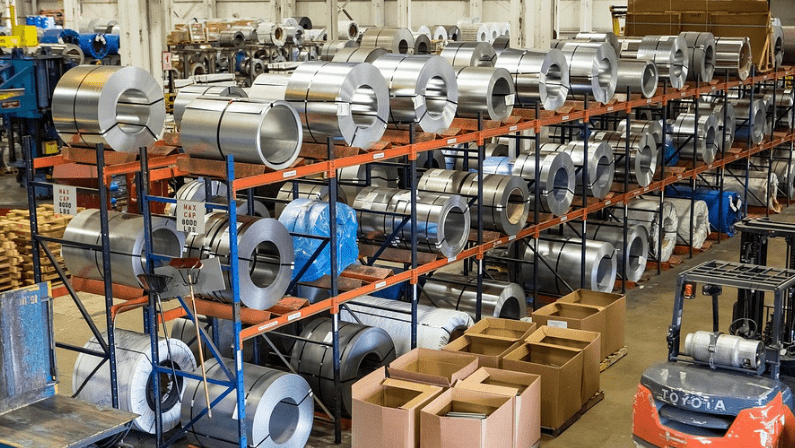
In warehousing, manufacturing, and commercial storage, space is currency. While companies expand, the demand for extra square footage becomes increasingly urgent. However, moving to a bigger building is usually fraught with high costs and disruption. And that is where pallet rack mezzanine systems provide a brilliant solution: they enable you to grow upwards instead of outwards, doubling your working floor area without adding to your building’s size.
Key Components of a Pallet Rack Mezzanine
Pallet Racking: The structural backing support system, usually consisting of upright frames and horizontal beams
Decking: The mezzanine level floor surface, usually constructed from plywood, steel grating, or bar grating
Stairs and Railings: Protective features designed to give access to the top level while avoiding falls
Columns and Bracing: Supporting structural components that provide stability and weight support
Safety Features: Such as kick plates, gates, and safety signage
The best thing about such systems is their modularity and flexibility. They can be structured to fit in nearly any commercial building or warehouse, working with existing infrastructure like sprinkler systems, lighting, and HVAC units.
Advantages of Having a Pallet Rack Mezzanine Installed
The most apparent benefit to a pallet racking mezzanine is the phenomenal gain in usable space within the building. Upgrade your space with a pallet rack mezzanine system. By installing it, you can reclaim the wasted vertical space and essentially double your square footage without changing the building’s footprint. It’s an intelligent, scalable solution that optimizes efficiency and maximizes every cubic foot of space in your facility.
Cost-Effective Expansion Solution
Compared to the other options—moving to a larger building or adding on to a building—pallet rack mezzanines possess major cost benefits:
- No costs for acquiring real estate
- No added property taxes or new lease terms
- Less expensive construction than standard building additions
- Minimal interference with current operations
- Possible tax advantages (mezzanines are often able to be taxed as equipment, not permanent building additions)
For most companies, the return on investment of a mezzanine system may be achieved in a matter of a few years, which is why it makes a good fit for expanding firms.
Versatility and Flexibility
Pallet rack mezzanines can be tailored to perform any of the following functions:
- Additional storage room for inventory
- Raised working areas for assembly or packaging functions
- Office space with observation over the production floor
- Dedicated space for unique functions such as quality control or shipping Preparation
The systems can also be reconfigured or expanded as your needs evolve, providing the flexibility that conventional buildings just can’t offer.
Enhanced Workflow and Organization
With careful design, a mezzanine system can enhance your operational efficiency considerably:
- Divide up disparate functions (e.g., store below and process above)
- Create designated areas for specific categories of inventory
- Develop clear visual management systems
- Minimize clutter on the main floor
- Enhance supervision and monitoring of operations
Upgrading Your Space: Planning and Implementation
Transforming your facility with a pallet rack mezzanine requires careful planning and consideration of several key factors.
Assessing Your Needs and Space
Before proceeding with a mezzanine installation, conduct a thorough evaluation of your current space and future requirements:
Current Space Utilization
- Map out how your current space is being used
- Identify inefficient areas or underutilized vertical space
- Determine your current storage space and workspace requirements
Future Growth Estimates
- Project your space needs for the next 3-5 years
- Factor in seasonal inventory or staff changes
- Provide for new product lines or process changes
Construction Restrictions
- Ceiling height and structural restrictions
- Placement of utilities, sprinklers, and HVAC equipment
- Loading area and access points
- Building codes and zoning ordinances
Design Elements for Maximum Functionality
Collaboration with seasoned mezzanine designers and engineers is integral to developing a system that fulfills your unique requirements while providing safety and compliance.
Weight Capacity and Structural Integrity
An adequately designed pallet rack mezzanine system will have to consider both live loads, e.g., people, equipment, and mobile objects, and dead loads, e.g., the building itself and any permanent installations. Trained engineers carefully compute critical elements, such as beam and column sizes needed, proper decking materials and thickness, required bracing and reinforcements, and proper foundation support.
Access and material movement are also crucial considerations, including care in where and how staircases are located and designed, the possible integration of conveyor belts or vertical elevators, and such features as pallet gates or material handling doors to facilitate travel between floors. Visibility between levels should be maximized to optimize workflow and communication.
As vital are safety devices, which need to incorporate OSHA-compliant guardrails (usually 42 inches high), toe boards for stopping falling debris, adequate illumination throughout all working areas, easily readable signage regarding weight capacity and safety procedures, and fire protection systems that coordinate well with existing building infrastructure. All of these factors combine to produce a practical, safe, and effective mezzanine system.
Maximizing ROI Through Smart Design
To get the most value from your mezzanine investment, consider these strategies:
- Multi-use design: Create spaces that can serve different functions as needs change
- Phased implementation: Start with a smaller system that can be expanded later
- Integration into current systems: Ensure the mezzanine integrates seamlessly with your existing racking and material handling equipment
- Future-proofing: Provide space for technological upgrades and shifting operational requirements
Installation Process and Timeline
Knowing the installation process prepares you for the project and reduces the impact of the project on your operations.
Pre-Installation Planning
Permits and Approvals: Collaborate with your contractor to secure building permits and meet local codes
Site Preparation: Remove the installation area and make adjustments to existing infrastructure as needed
Material Delivery Scheduling: Schedule delivery of components to reduce storage needs
Operational Adjustments: Consider how to keep operations running during installation
Installation Steps
- Foundation preparation: Preparing the floor to bear the structure
- Frame assembly: Assembling the pallet rack uprights and beams
- Bracing installation: Installing cross-bracing for stability
- Installation of decking: Installing the floor surface of the mezzanine
- Railings and stairs: Installing the access points and safety features
- Final touches: Installing lighting, electrical connections, and other utilities as required
Timeframe Expectations
The installation period depends on the size and level of complexity of the system:
Small systems (< 1,000 square feet): Usually within 1-2 weeks
Medium systems (1,000-5,000 square feet): Usually within 2-4 weeks
Large or complex systems: May require 4-8 weeks or more
It’s often possible to minimize downtime and smooth the transition with the help of experienced installers.
Maintenance and Safety Considerations
Regular inspections and maintenance are necessary to preserve your investment and maintain workplace safety.
Routine Maintenance Tasks
- Quarterly inspections of structural elements for signs of deterioration or wear
- Annual professional evaluation by trained engineers or mezzanine experts
- Routine cleaning of decking surfaces to avoid slip hazards
- Inspection and tightening of all connectors and bolts
- Mechanical component testing, such as gates or lift systems
Safety Procedures
Enforce explicit safety procedures for mezzanine use:
- Display weight capacity limits in prominent locations
- Educate staff on the proper use of stair and material handling equipment
- Develop cleaning and maintenance schedules
- Develop emergency evacuation plans that incorporate the mezzanine level
- Perform routine safety drills
Regulatory Compliance
Pallet rack mezzanines have to meet several different building codes and safety standards:
- International Building Code (IBC) Structural design specifications
- OSHA regulations for the safety of the workplace, such as requirements for guards
- Local zoning laws that may influence modifications to the building
- Fire code specifications for sprinkler protection and emergency egress
- ADA accessibility standards, if used by the general public, such as visitors or customers
- Collaborating with seasoned mezzanine designers ensures your system complies with all relevant requirements.
Conclusion:
With today’s competitive market, maximizing the use of your existing facility is more important than ever. A pallet rack mezzanine system offers a cost-effective, intelligent solution to space constraints, allowing you to expand upwards rather than outwards.
As you seek alternatives to expand your space, a pallet rack mezzanine must be seriously considered. By proper planning, professional design, and quality construction with Space Aid Manufacturing, it may be the turnkey solution that your company needs to thrive at its present site for years to come.
Regardless of whether your objective is to expand storage capacity, offer additional workspaces, or simply better utilize your available vertical area, a pallet rack mezzanine system is a future investment in your facility that can offer immediate and long-term rewards.




